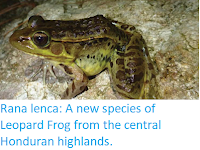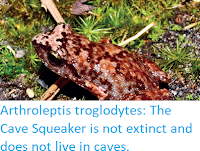The Andes Mountains of South America are form one of the most biologically diverse regions of the Earth, due to the huge range of habitats found on the slopes of the mountains as they cross a vast span of climatic zones. The paramo ecosystem is found on the high slopes of the northern Andes between northern Peru and Venezuela, with outliers in the mountains of Panama and Costa Rica in Central America. This ecosystem is found above the forest-line (around 3000 m in this area), but below the permanent snow-line, and is dominated by bush-grasses, rosette and cushion plants, mycrophyllous and dwarf shrubs, and geophytes. Amphibians are generally rare in high-altitude environments, but the paramo is home to a wide variety of Frogs, including many insular species with very limited ranges, cut off from other areas of similar environments on separate mountains.
In a paper published in the journal ZooKeys on 20 April 2018, Juan Sánchez-Nivicela of the Laboratorio de Herpetología at the Museo de Zoología de la Universidad del Azuay, and the Instituto Nacional de Biodiversidad, Elvis Celi-Piedra and Valentina Posse-Sarmiento, also of the Laboratorio de Herpetología at the Museo de Zoología de la Universidad del Azuay, Verónica Urgiles, again of the Laboratorio de Herpetología at the Museo de Zoología de la Universidad del Azuay, the Instituto Nacional de Biodiversidad, and of the Department of Biology at the University of Central Florida, Mario Yánez-Muñoz, also of the Instituto Nacional de Biodiversidad, and of the Museo de Zoología at the Pontificia Universidad Católica del Ecuador, and of the Diego Cisneros-Heredia, once again of the Instituto Nacional de Biodiversidad, and of the Instituto de Zoología Terrestre & Museo de Zoología, Instituto Biósfera and Instituto de Geografía, at the Universidad San Francisco de Quito, and of the Department of Geography at King’s College London, describe a new species of Frog from the high paramo of southern Ecuador.
The new species is placed in the genus Pristimantis, the most specieous genus of terrestrial vertebrates known with almost 500 species commonly known as Rain Frogs, and given the specific name erythros, meaning red. This species is a distinctive red colour, with a short snout and granular skin on its head and back. Females of this species are larger than the males, with examined female specimens reaching 38.8–42.6 mm, compared to 36.7–37.0 mm in the males.
The species was found in an area of paramos on the Cajas Massif, at altitudes of 3450–3500 m, mainly in terrestrial Bromeliads (Puya hamata) and Grasses (Neurolepis villosa), near to small streams. Given the small are in which the Frog were found, and the fact that this area was not in a protected area, Sánchez-Nivicela et al. recomend that the species be listed as Critically Endangered under the terms of the International Union for the Conservation of Nature’s Red List of Threatened Species.
See also...
Lateral, dorsal and ventral views of living specimens of Pristimantis erythros. Left, male; right, female. Sánchez-Nivicela (2018).
The species was found in an area of paramos on the Cajas Massif, at altitudes of 3450–3500 m, mainly in terrestrial Bromeliads (Puya hamata) and Grasses (Neurolepis villosa), near to small streams. Given the small are in which the Frog were found, and the fact that this area was not in a protected area, Sánchez-Nivicela et al. recomend that the species be listed as Critically Endangered under the terms of the International Union for the Conservation of Nature’s Red List of Threatened Species.
Habitat of Pristimantis erythros in type locality. Sánchez-Nivicela (2018).
See also...
Follow Sciency Thoughts on Facebook.








